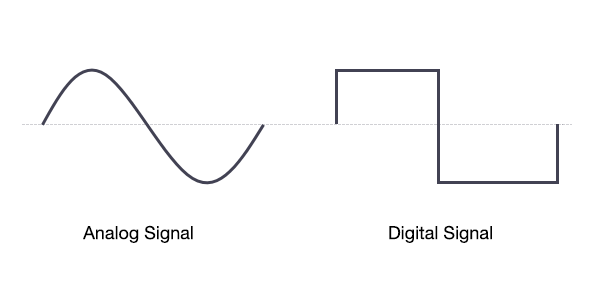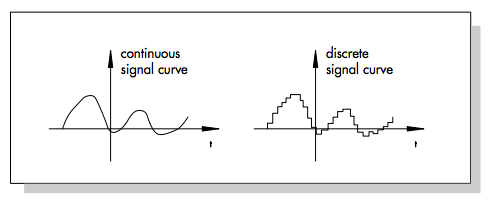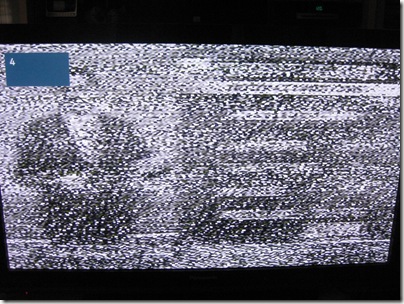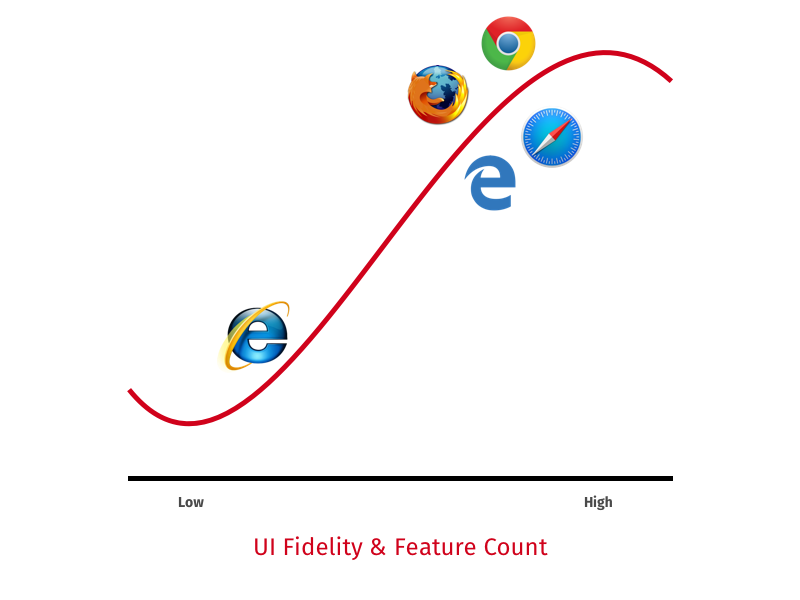The Analog Web
“The web is not a platform. It’s a continuum.” – Jeremy Keith
I’ve been thinking about this statement by Jeremy for a while—I’ve been thinking about how beautifully the concept of a continuum illustrates possibly the greatest strength of the web over native platforms.
A continuum is inherent to the very nature of an analog signal. Perhaps it is no coincidence the web’s makeup exudes traits of a continuum: it was, in fact, birthed from the transmission of data over continuous analog signals. Perhaps a continuum is inherent to the very nature of the web itself?
Perhaps the web is to continuous analog signals as native platforms are to discrete digital signals. To explain how I arrived at this conclusion i’ve got to start from the beginning. So bear with me while we start with a crash course in the differences between analog and digital signals.
Digital and Analog Signals
An analog signal is continuous, meaning that it contains no interruptions or breaks in its flow. A good example of an analog signal is the human voice. How Stuff Works illustrates:
Sound is naturally an analog signal ... If you were to hum a descending note, people hearing you would be able to detect the change in pitch, but not point to specific moments when the pitch jumped from one note to the next.
Digital signals, on the other hand, are not continuous. They are “discrete sampled signals” because they can only replicate sampled sections of an original continuus signal. In the same example of humming a note, a digital recording would be represented not as a continuously descending scale but a collection of shorter sounds which make distinct jumps down the musical scale.
This is exactly why some audiophiles will argue that analog recordings trump digital ones. Even with the newest technologies, digital audio still cannot create an exact replication of an original sound wave. Sure, the best trained human ear may not be able to tell the difference between a high quality digital signal and an analog signal, but theoretically the difference is there.
To illustrate, take a look at this graphic (image courtesy of Center Point Audio):

Notice the rigidity of the digital wave? The analog signal is continuous. It is without interruption. The digital signal, on the other hand, encodes the information contained in the analog signal into discrete signal states. That's what digital is: it’s binary. It's 1 or 0. On or off.

A binary signal can only represent two values, which is not very useful compared to an analog signal which can represent an infinite number of intermediate values. That’s why digital signals have to use several “bits”, or multiple 1’s and 0’s, to represent points on a wave.

When you pack enough binary values into a single point on a wave, the digital signal begins to more accurately represent the an analog signal. Center Point Audio gives us an easy way to visual this:
An easy way to visualize digital audio is to consider the difference between a regular light bulb and a strobe light (Those lights designed to flash on and off very quickly. Commonly found at concerts or Halloween displays). In this example, an analog audio signal is comparable to a regular light bulb, whereas a digital audio signal would be similar to a strobe light. A strobe light can flash so fast that you hardly notice the moments when it is off.
The analog signal (light bulb) is continuous and you don't even see the on/off states. Whereas a strobe light has distinct on/off states. However, if you flash the strobe light fast enough, your eye will not perceive the difference between the discrete states. This will make the strobe light appear continuous like a normal lightbulb.
So why do we even have digital signals if analog ones are ”of higher resolution”? The primary disadvantage of analog signals, in comparison to digital signals, is the unavoidable introduction of random, unwanted noise (which is dependent upon the medium). This introduction of noise invariably degrades the “signal-to-noise” ratio, progressively degrading the signal’s strength to a point at which it is no longer recognizable. Digital signals, on the other hand, can be processed, transferred, and stored without introducing noise. So if most people don’t even notice the difference in quality between digital and analog, why stay with analog?
Analog and Digital Signals in Television
When I grew up, we had OTA (over the air) analog television. This meant we had an antenna on the roof which picked up analog television stations being broadcast in the area. Usually this included national stations with local affiliates like ABC, NBC, CBS, and FOX as well as a few public TV stations like PBS.
Because the TV reception was analog it was subject to interference, resulting in some channels being more clear than others. Most of the channels came in clear at our house except for one: Univision (or the "spanish channel" as my siblings and I called it). For whatever reason, this channel always had lots of interference which resulted in the image often being barely distinguishable.

For most members of my family, not being able to watch the spanish channel wasn’t a big concern. But it concerned me. Back then (and still somewhat today) soccer was obscure in American sports, so none of the major TV stations like ABC or NBC carried the big soccer matches. In the days before the internet, this made it very difficult for me as a 14-year-old kid to watch any matches. There was, however, one channel that always broadcast the soccer games and it was that fuzzy, hazy, barely-distinguishable, foreign-language spanish channel. I came to love that channel. Sure, the games were in a different language and the image on screen was incredibly low quality, but when the big games were on, none of that mattered. All I cared about was accessibility (not my web terminology here). Sure, crystal clear video and English commentators would've been nice, but those were all “enhancements” to me. Just getting the video signal was good enough for me.
Now-a-days, all the OTA television have switched to digital. Sure DTV has its upsides, clearer picture and what not, but I kind of miss the old analog. Sometimes, when I go home to my parents, I’ll switch over to the spanish channel to catch a game. But the signal is digital now, so it has to come in perfectly clear or I will see nothing at all. This is actually quite frustrating. Often a show will play for 3 seconds, then pause for 15 seconds, then skip forward. It's not continuous. It's broken up, and it's frustrating to watch.

This is known as the “digital cliff effect”. While analog signals gradually degrade in quality with the introduction of interference, digital signals ”provide data which is either perfect or non-existent”. Digital signals work to a certain extent and then you go over the “digital cliff” and everything falls apart and you get no picture at all.

If you live in an area of degraded analog signal quality (such as remote rural areas) you’ll receive a degraded and snowy picture but it’ll still watchable. With digital, however, you either get a perfect picture or no picture at all. You can see an example of the cliff effect over on YouTube.
I have to admit, sometimes I wish I was still receiving the analog TV instead of digital TV. The channels weren’t always persistent in quality, but they were always accessible. Perhaps you can see how that leads me to the web.
The Analog Web
There was a time, I think, when we ushered out analog TV with torches and pitchforks, "out with the old, in with the new!" OTA HDTV offered so much: better picture, better audio, better everything (or so we were told). But we lost something along the way—we lost the continuity of the analog.
I find it ironic that the early web used modems which encoded/decoded internet protocol packets into analog signals transported over phone lines. The web, a continuum, first leveraged continuous analog technology. Is it possible that the identity of the web borrowed aspects of its original medium in forming its ethos of accessibility? One can speculate.
Jeremy Keith points out the web's unique position of universal accessibility and its relationship to design by calling it a "continuum". So what exactly is a continuum?
Continuum: a continuous sequence in which adjacent elements are not perceptibly different from each other, although the extremes are quite distinct.
If we narrowed in on wavelengths to the space between the trough and the crest of a wave, you would find the analog wave being a continuous sequence, or continuum, as adjacent elements are imperceptibly different from each other. In contrast, a digital wave must 'sample' the continuity of an analog wave and choose discrete pieces to represent in binary format.
The web is like an analog continuum, subject to interference. The "signal quality" of the web is subject to the web's unique components which introduce interference, such as browser or device type. IE8 introduces more "interference" into a site's visual design and functionality of features than the latest version of Chrome. But if a website truly adapts the mission of the web (universal accessibility) it will be no less accessible.

This is what makes the web fundamentally different than native platforms. Websites don't need to look exactly the same in every browser. And that's not a weakness of the web, it's a strength. Jeremy expounds:
[At the outset of the web] designers and developers were comparing the web to print and finding it wanting. These days, designers and developers are comparing the web to native and finding it wanting. In both cases, I feel like they’re missing the fundamental point of the web: you can provide universal access to content and tasks without providing exactly the same experience for every single browser or device. That’s not a failing of the web — that’s its killer app.
when we talk about “the browser” as if it were a single entity we might be unconsciously reinforcing the expectation that there is one Platonic ideal of browser rendering and that’s what we’re designing for.
Trying to imitate the traits of native platforms on the web while shunning the web's fluidity can be detrimental and limiting. We think we're doing users a favor by leaving features or content inaccessible on the web because they would "look bad", but the web isn't about looking pretty. The web, I would argue, is about about the very thing we're sacrificing: accessibility to content.
Historically, other mediums have sacrificed "quality" for accessibility. Take movies for example. Movies are often shot and optimized for the theaters: 16:9 ratio, 3D effects, digital surround sound, etc. But in order to work in other contexts, they are often diminished in quality: 16:9 is cut down to 4:3, 3D effects are removed, surrounded sound is converted to stereo. We've all seen the message, "this movie has been formatted to fit your screen". You see, even though movies are optimized for the big screen, watching them on an airplane in 4:3 ratio with grainy quality and stereo sound still works. It's about the content when you want it, when you need it.
It would be a shame if hollywood thought of movies as optimal only in the medium of the movie theater. Imagine renting a movie on iTunes and seeing the message, "this movie is best displayed in theaters. Go to a local theater to watch." Or, perhaps worse, what if you rented a big-budget action movie on your smartphone and saw the scenes of dialogue but when the big action scenes came along, all you got was a blank screen with the message, "this is best viewed in a theater". Or what if you could only rent movies on projectors made by the movie studios? And yet this is precisely what we are doing on the web. We show messages like, "please use this feature on our app" or "this content is only accessible from the desktop".
The web is about continuity. It's about accessibility, no matter the device, browser, screen, etc. Platforms like iOS, Android, even Flash, they do not and cannot offer what the web offers. Jeremy expounds:
What I mean is, if you use the Flash platform, then anyone with the Flash plug-in can get your content. It’s on or off. It’s one or zero; it’s binary. Either they have the platform or they don’t. Either they get all your content, or none of your content.
And it’s similar with native apps. If you’ve got the right phone, you can get my app. All of my app. You don’t get bits of my app, you get all my app. Or you get none of it because you don’t have that particular phone that I’m supporting.
And the web is not like that. The web is not binary, one or zero, on or off. It’s not a platform where you get one hundred per cent or zero per cent. It’s this continuum.
The web is a continuum. It's like my old analog TV. It’s not exactly like DTV. Nor can it match it in some areas of functionality. It does, however, have other strengths. When digital TV fails, it fails completely. Analog TV, to use parlance of the web, degrades gracefully. The web could be similar, if we choose to make it so. It could be “the analog” web in contrast to “the digital” platforms. Perhaps in our hurry to replicate and mirror native platforms, we're forgetting the killer strength of the web: universal accessibility. Sure, I love the new HDTV signals. But it's incredibly frustrating when a game comes on and I can't watch it because of the digital cliff. At that moment, the trusty old analog signal is there. Sure it's hazy and has all kinds of noise, but it's there. I'll gladly take that. And so it goes with the web. Sure, native might be a better experience, but that's just one measurement stick. At least I'll always know the web has my back, that what i'm looking for will be accessible. But if I don't even have that, then what's the web for?